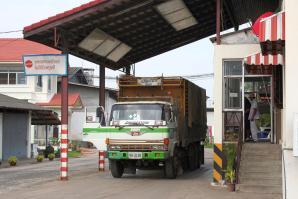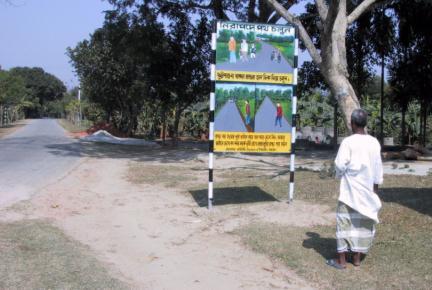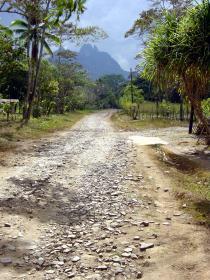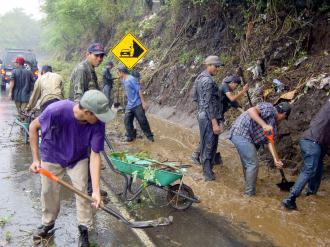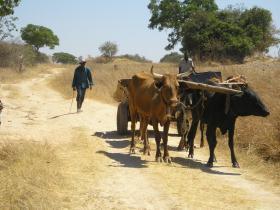Knowledge fuels change
For over a decade, Energypedia has shared free, reliable energy expertise with the world.
We’re now facing a serious funding gap.
Help keep this platform alive — your donation, big or small, truly matters!
Thank you for your support
Promoting Rural Development through Mobility
Overview
Mobility is a key element in the economic and social development of rural areas. The following article gives an overview about the interdependencies of Transport and rural development. Moreover, the possible impacts of infrastructure measures, the stakeholders, competencies and responsibilities during the planning process at local, regional and national level and in this context the need for international intervention are discussed.
Rural Transport and Territorial Development
Rural development involves more than just agricultural production: it is also closely linked to the economic utilisation of these products and the provision of basic social and economic services (see also article: Access to Transport). At local village level health and education facilities, supplies of means of production, alternative economic sectors and income-earning opportunities are often non-existent or very basic, making access to these things difficult.
Supra-regional links must therefore be improved or created in order to improve the socio-economic position of the rural population. Infrastructure measures make it easier for rural dwellers to link into regional and supra-regional economic life, and also facilitate access in the reverse direction. The previous local focus must therefore be replaced by greater territorial and even supra-territorial openness. Territorial development (GIZ 2012) therefore involves organising planning and construction processes according to the subsidiarity principle, with corresponding funding. This development can take place along one or more axes (country development axes) or corridors that are based on main transport arteries and use secondary transport routes as links.
Impacts of Infrastructure Measures
The positive impacts of infrastructure measures in the transport sector are therefore particularly large if they are embedded in a strategy of territorial development – that is, in a balanced development plan that involves the entire region. An important aspect of such plans is a functional and administratively well-organised division of labour between spatial centres, sub-centres and sparsely populated areas, and between different organisations and institutions. Despite being closely linked to other packages of measures, the impacts of investment in infrastructure as a component of spatial development and land-use planning are relatively easy to measure. These impacts include the following:
|
Good transport infrastructure facilitates economic development: a lorry sets out on its journey from a rural rice mill to the end purchasers.[1] |
- Raw materials can be delivered both faster and more cheaply to distant markets, and can more readily be processed locally --> regional and supra-regional sale and producation of sensitive and local products. Moreover, markets in neighbouring regions can be accessed and diversified.
- Price fluctuations can be exploited more quickly and more promptly.
- It is easier for purchasers to access producers.
- It becomes easier to establish economic opportunities social services, such as health and education, and access to these services is therefore improved.
- The availability of means of production (tools, machinery, seed, fertiliser) is improved.
- Professional advice services, including private ones, can more readily be provided in rural areas.
- The need of urban population groups for nearby recreational facilities opens up new development potentials and alternative income-generating opportunities
- Transport costs are reduced; as a result, goods become cheaper for producers, traders and end consumers. Journeys become both shorter and faster.
- The risks arising from transport difficulties or failures are reduced. Transport materials are saved and there is less damage to goods.
- There is greater scope for inter-municipal links and inter-municipal exchange. Contact between local government workers and the rural population is improved --> participation in political events.
- Construction projects commissioned by local authorities (e.g. erosion control measures, construction of markets, stores or grain banks) can be completed faster and at lower cost.
- Transport routes stimulate the migration of labour. Rural areas benefit from additional investment and innovation as a result of remittances and the return of migrants.
Corridors that are initially established purely for transport purposes can also have a beneficial knock-on effect on territorial development, since they can be designed to link a number of territorial areas. Trunk roads typically lead from the capital city to a neighbouring country via another large city, passing through several rural communities on the way. By means of rural and inter-village paths, these communities link their territory to the trunk road and hence to larger cities and to neighbouring provinces and countries, as well as to neighbouring communities. The trunk roads are used as corridors, from which access is created at both local/community and national/international levels. For landlocked countries, corridors to free ports in coastal countries are important. The transport activities themselves create new economic opportunities, which open up along these corridors. These potentials also radiate into the hinterland. It is therefore justifiable to state that corridors can become real axes of development.
Stakeholders, Competencies and Responsiblities
Work on rural transport routes is usually commissioned by a municipality or other regional or local body that has a vested interest in improving the economy in its rural areas but also finds itself confronted with new challenges. In the first place, maintaining and repairing the infrastructure will give rise to significant costs. Secondly, adverse effects are also likely, particularly in relation to natural resources.
Municipalities and decentralised government are of prime importance in the list of stakeholders.
- The state is the highest planning authority (planning sovereignty; drawing up and implementing master plans) with ultimate financial authority over the national budget.
- State bodes as representatives of the state authority at decentralised level take on planning, training, instructional and monitoring tasks in connection with technical implementation of infrastructure measures.
- The territorial authorities (e.g. municipalities) or other local and regional bodies have initial jurisdiction for all development measures in rural areas, and as commissioners of the construction work they are responsible for the needs analysis, technical planning, invitations to tender, initiation of the measures and technical, financial and administrative management. Ensuring sustainability – for example through repair and maintenance work – is particularly important here. Local and regional authorities should detail all development measures – especially those involving transport development – in their development plans or in local development strategies and take responsibility for implementing them. These development measures should be coordinated and adapted at both local/municipal and national/trans-national levels.
- Local bodies such as village development committees play an active part in needs analysis, implementation and maintenance.
- Technical and financial partners support implementation by funding and supervising measures in the areas of capacity building, planning, implementation and management of construction measures and by supporting the economic development process.
- The same applies to projects that operate by arrangement with state bodies and local authorities and to organisations such as NGOs, associations, societies and foundations.
- Private companies and private service providers work on a contract basis or are involved through PPPs.
|
Road maintenance work is often the responsibility of local authorities[2] |
Need for Intervention
In many countries the decentralised bodies at regional and local level are recently established, have poorly trained staff and are often not fully operational. Skills and capacities are poorly developed. Frequently no funds at all are available for ensuring sustainability, carrying out maintenance and repairs, commissioning private companies or maintaining political and administrative links with other local authorities.
The responsibilities and duties of these bodies (such as local community authorities) are being significantly increased: this entails major risks, since in rural areas responsibility often lies no longer with the state but with these very bodies and structures at regional and local level. The bodies concerned are often unequal to the workload and the degree of challenge and are unable to carry out their duties in full. Since state services (even deconcentrated ones) are often very bureaucratic and slow to respond, it is important that tasks such as implementation and maintenance are decentralised. If the regional aspect is not taken into account at planning level, it will be hard to implement at municipal and local level.
Purely technical expertise usually exists at national level but at regional level it is likely to be in short supply or difficult to access. Although the situation in this regard varies widely between countries and regional structures take different forms, the principal need for action (in addition to financial support) is for capacity development in the following areas:
- responsibilities – rights – duties
- planning approval procedures – environmental assessments – development plans
- administrative and financial procedures (tendering process)
- compensation
- authority over transport routes
- explanation of the applicable legal framework
The following questions should therefore be considered in connection with all measures that affect the territorial aspect:
- What legal rights does the state grant to regional and local bodies?
- Can they conclude contracts independently? Are they allowed their own bank accounts? Can they act in the name of the local population without restriction?
- How can the interaction between the macro, meso and micro levels be organised with regard to mobility?
- What right of input and what influence do state, national and regional authorities and bodies have in relation to municipal and village-level decision-making, and vice versa?
Road safety measures in a rural area of Bangladesh[3] |
Starting Points in the Transport Sector
Planning at National and Regional Level (Transport Master Plans)
The planning process has to be considered at a national and regional level which should be integrated with other areas of regional planning:
|
National level
|
National government
|
National Transport strategy / policy
|
Strategic coals for country's development:
|
|
Regional level
|
Regional government
|
Regional development plans
|
|
One of the aims of integrated regional planning should be to ensure that infrastructure-related investment and running costs are manageable. Routes for non-motorised traffic should therefore be promoted as well as motorised transport routes. Women benefit particularly from improved accessibility at local village level: they have little access to means of transport but at the same time they often bear the main burden of the family’s mobility needs.
Infrastructure
Appropriate Methods of Building Rural Roads
Demand-oriented, labour-intensive, climate-resilient: Approaches to rural road-building
The type of route that is appropriate and the materials that should be used depend in any specific case on many factors. If roads are used by heavy lorries or if heavy rainfall is frequent, asphalt roads are appropriate. Where routes carry little traffic or are used mainly by pedestrians and cyclists, work can focus on improving gravel and laterite tracks and simple field paths. Construction costs and the affordability of subsequent maintenance are important considerations here.
|
Secondary roads are often used and maintained only by the local population.[4] |
Direct contribution to poverty reduction: Labour-intensive road and path construction
Significant investment in rural transport infrastructure often has great potential for direct and short-term poverty reduction in the area in which the construction work is carried out. For many years, therefore, labour-intensive work has been the approach used. For each dollar of capital spent, this generates up to seven times as much employment as conventional road-building (McCucheon 2008). At the heart of this approach is the principle of involving the local population in construction and preparing them to take responsibility for road maintenance activities. Where possible, heavy machinery is not used, provided that this does not adversely affect the required construction quality and that the necessary construction standards can be met. This also reduces adverse environmental impacts during the construction phase. Where local resources so permit, construction materials from the region can also be used.
The advantages of labour-intensive road- and path-building projects are now well documented. As a result of the greater emphasis on gender aspects, more women are now being employed in many programmes; this enables the women not only to earn an income for themselves and their families but ideally also to improve their standing in society. At the same time, however, experience of labour-intensive projects also shows that such measures require careful planning, thorough training of participants and a sound strategy for the funding of subsequent maintenance. Without these things the sustainability of the initial investment and the development impacts above and beyond the short-term employment effect cannot be guaranteed.
Planning and building with an eye to the future: The challenges of climate change
The rural transport infrastructure in many newly industrialising and developing countries is increasingly at risk from the consequences of climate change. More intensive and longer-lasting heat waves damage the materials used for road surfacing, while heavy rain and more frequent floods make many roads and tracks temporarily or even permanently impassable. These factors must be taken into account when investment in the rural transport network is being considered. Vulnerability analysis is a useful first step. Such an analysis shows which regions will be affected in the medium to long term by which impacts of climate change. This enables the need for adaptation to be identified not only in relation to the rural infrastructure but also for the rural area and its inhabitants as a whole. As a rule, higher design standards for roads and tracks usually involve higher costs and more elaborate construction measures. The latter, in particular, may sometimes conflict with the principles of labour-intensive work described above. Analysis of flood damage to rural paths in Cambodia after the devastating monsoon rains of 2011 has shown that tracks built using labour-intensive methods were particularly badly affected.
At the same time, it is necessary to set priorities. Not every road and path can be built or repaired to the highest standards in the short term. What is needed here is forward-looking planning that takes account of numerous considerations:
How will rural communities in general be affected by climate change, and what changes in mobility behaviour are to be expected in consequence?
What roads and paths are important during and after climate-induced events to ensure a minimum of access to basic services and to workplaces?
In the event of a disaster, what routes must be passable for purposes of evacuation or the deployment of aid forces, and what routes might fulfil a second function, for example as a final refuge from floods?
Such considerations are important in order to set priorities for investment that take the impacts of extreme climate events into account.
Road flooded after heavy rain.[5] |
Maintenance and Financing of Transport Routes
Transport routes can only be of lasting benefit if they are conserved and maintained long-term. By comparison with new investment, the level of annual expenditure required for this is low (approx. 2.5 per cent of the replacement value of the entire road network). Responsibility for maintaining the primary road network is usually located at national level, while secondary and rural roads are frequently the responsibility of the municipalities. Decentralisation of decision-making powers requires municipalities to have the necessary financial budgets permanently available; they also need technical support and help with maintenance planning from the government. Roads in rural areas are predominantly gravel and laterite roads or unpaved tracks. Regular maintenance is therefore usually feasible without major technology or use of machines, and it can be quickly learned. The relevant training must be provided by the government. If high seasonal rainfall or extensive use by heavy lorries puts the road paving under severe strain, technical assistance as well as increased funding must be made available.
Supporting decision-making in relation to maintenance of roads with low traffic volumes calls for models that use simplified means of measuring traffic volumes, vehicle operating costs and time costs and other appropriate replacement indicators such as traffic safety, benefits for non-motorised transport, social function and environmental effects (such as the World Bank’s Roads Economic Decision Model). Road maintenance is under-financed in most countries. The World Bank’s Road Maintenance Initiative (RMI) has established that national budgets for road maintenance and road-building in Africa rarely cover more than 30 per cent of the need; in the case of rural roads, funding is usually even more inadequate. The funding of maintenance is managed in different ways in the developing countries. In recent years many countries have introduced road funds that are designed to enable funding to be more independent of national budgets, instead involving contributions from road users in the form of fuel surcharges or levies on heavy lorries. Only in exceptional cases can road-use charges be set so high that they cover the cost of maintaining and repairing the entire road network. In addition, the maintenance of rural roads cannot be considered from a purely economic perspective, since on the basis of economic criteria alone such roads would often not be worth maintaining. This means that for little-used roads a policy of levies and charges on the ‘polluter pays’ principle is not feasible. As a result, the road funds often cover only the primary road network completely, while secondary and rural roads are cross-subsided, with a certain proportion being provided from the road fund. In Namibia the charges paid by road users are used only for roads whose economic benefit can be demonstrated. ‘Social roads’ are still funded from the state budget. Overall, therefore, the importance of road funds for the maintenance and repair of rural roads is small. A performance-related contract system provides the state bodies that transfer funds for road maintenance to local governments with a degree of assurance that these funds are being used appropriately. Performance-related pay ensures that quality standards are complied with, and through flexible working practices it makes it easier for women to enter employment.
Assuming responsibility for the road network provides municipalities with opportunities to use their limited funds for maintenance and repair in the ways that yield the greatest benefit for the district. It enables them to set their own priorities for maintenance or to reduce maintenance costs, for example by introducing locally adapted road-building standards (e.g. reduced carriageway width). Another option is to find local sources of funding for road maintenance (e.g. market charges). Mine owners and local businesses that generate high volumes of heavy traffic should make an appropriate contribution to the costs of road building and maintenance. This should apply not only to roads that the mines or businesses need in order to operate and in which the business owners therefore have a vested interested: other infrastructure commitments in the region should be undertaken through concessions.
Improving Mobility Services
Donkeys, oxen, pickups, minibuses: Transport services in rural areas
International development cooperation in the field of rural mobility has focused and continues to focus on the construction and maintenance of infrastructure. Far less attention has been paid to the provision of services for the transport of people and goods, and within state-sponsored development work there are relatively few examples of successful schemes for improving transport services themselves. It is often assumed that the relevant services will automatically come into being once a good-quality road is available that makes the use of vehicles belonging to private providers cheaper and easier.
The situation is more difficult in rural areas characterised by a combination of relatively low population density and very low incomes. In such places inadequate infrastructure is a major barrier to better mobility, but not the only one. In many countries in sub-Saharan Africa the urgently needed provision of effective mobility services is hampered by the lack of potential for the transport of passengers and goods and by inefficient management and the formation of cartels among providers. A pickup in rural Thailand covers 61,000 km annually – twice the distance covered by a comparable vehicle in Ghana (Ellis, Hine 1998) – making the market significantly more lucrative for transport operators in Thailand. By contrast with many countries in Asia, sub-Saharan Africa is hindered not only by barriers that arise from settlement patterns and institutional/organisational problems but also by the higher costs of vehicles and spare parts. Some countries – such as Sri Lanka with its ‘Gami Saeriya’ programme – have developed schemes whereby bus transport in rural areas is put out to tender and subsidised for at least the initial few years (in the case of Sri Lanka subsidies cover up to 25 per cent of operating costs in the first three years) (Kumarage et al. 2009). In such cases facilitating personal mobility is regarded as a basic public service – a concept that is familiar from European countries and one that deserves to be more strongly applied in developing countries, despite the expense involved. This contrasts with the micro level of transport of people and goods to the nearest market, often on simple tracks and paths, where pioneering work has been done by non-governmental organisations – often with the support of international donors. In connection with the transport of larger quantities or perishable goods, the use of information and communication technology and of freight brokers can increase the quantity of goods to be transported to a cost-effective level and prevent empty journeys. Where the private transport sector is itself a part of the problem as a result of cartels and mismanagement, the only solution lies in reform of the sector (which is often difficult to implement in rural areas) and in-depth discussions with operators and their associations and federations. Support and training in vehicle maintenance and more efficient management can help to overcome resistance and boost competition and professionalism in the transport sector.
| Providing beasts of burden and farm animals in return for a fee can be an additional source of income for farmers.[6] |
The private sector’s domain: Trans-regional logistics
At the level of trans-regional transport the role of public institutions in connection with freight transport and the majority of passenger transport is largely limited to the creation of an enabling environment and – as described above – public policy measures designed to encourage deregulation and competition. Many of the options at this level can significantly assist economic development in rural areas, although the effects tend to be only indirectly noticeable. There is major potential for governments to reform and professionalise police and customs agencies, with the aim of reducing corruption and bureaucracy. In Nigeria, for example, German development cooperation is helping to establish an SMS-based information system about illegal road blocks and bribery payments. As with the system financed by USAID (Section 2.2.3) the ultimate aim of this is to reduce costs for transport operators. International cooperation can also make an important contribution by helping state and private operators to improve the efficiency of major infrastructure facilities such as ports. A more detailed study should be undertaken to identify and describe the opportunities in this field.
Outlook
The preceding chapters have shown that mobility is a key element in the economic and social development of rural areas. Despite the steady progression of urbanisation in most of the partner countries of German development cooperation, rural areas still have an important part to play since they provide food and environmental services such as water for urban centres. Further urbanisation cannot take place without functioning and effective rural areas with active urban hubs for trade and transport. Issues such as food security and the continuing high levels of poverty in most rural regions further underline the importance of territorial development for a holistic process of development. From the perspective of German development cooperation, the following points should be borne in mind if the vital role of transport and transport infrastructure is to be considered and its potential harnessed:
Rural development requires investment in many areas. Close coordination of financial and technical cooperation boosts the effectiveness and impact of aid enormously, especially in the case of projects involving infrastructure improvements. Tried and tested instruments of financial cooperation, such as labour-intensive road-building, should ideally be complemented by policy advice and training courses in order to prepare for subsequent maintenance and embed the individual projects in a comprehensive strategy.
Experts in transport and agriculture can do more to work together on analysing the need for transport infrastructure and services, with a view to improving the productivity of farming as the engine of economic growth in many rural areas.
It is also important to promote decentralisation, in both the use and the planning, financing and implementation of infrastructure measures. Support must not be confined to the purely technical level but must respect the socio-political context and adopt a territorial perspective on development (see Section 3.1.1).
The pool of experts and sources of knowledge on the subject of rural transport has diminished steadily in recent years. In view of this, it is important to join forces with other regional and international actors in order to benefit from synergies and supplement skills. German development cooperation should therefore encourage networking and engage actively with other international cooperation organisations, NGOs and not least technical experts in its partner countries. There is particularly significant potential for cooperation in the scaling-up of best practices.
There is a need for better integration of transport and development planning at different spatial levels. Improved integration will also help to improve understanding of the links between rural mobility and urban/rural relationships, and between rural mobility and trans-regional freight transport flows. Realistic framework plans and efficient implementation are important foundations for economically promising development. From the past experience of German development cooperation (see also the appendix) it is possible to identify the following objectives and approaches that – individually or in combination – could serve as guidelines for future involvement in the field of rural mobility: Poverty reduction: labour-intensive road-building with intensive involvement of the local population
Boosting agricultural productivity: interventions in infrastructure and transport services, specifically tailored to the needs of small-scale farmers
Sustainability and decentralisation: improving capacities for infrastructure maintenance, especially at regional and municipal level
Knowledge management: encouraging international dialogue and the exchange of expertise and best practices relating to all aspects of rural mobility and access to transport.

